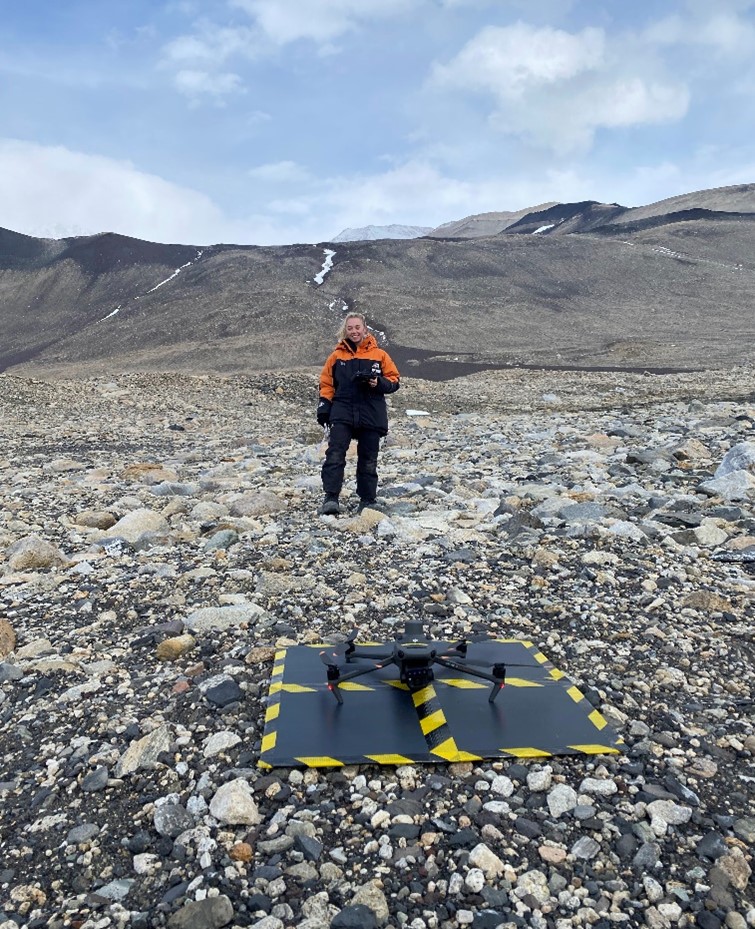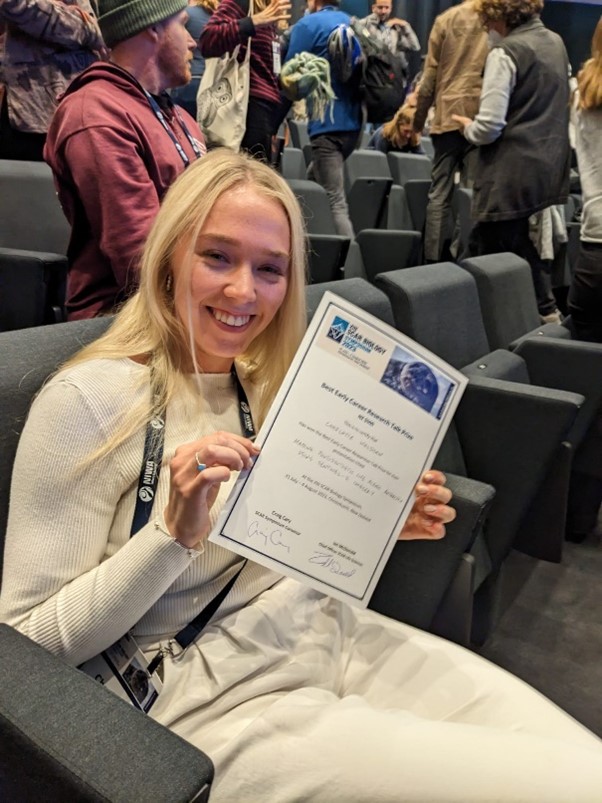Name: Charlotte Walshaw
Institution: University of Edinburgh
PhD Project title: Mapping photosynthetic life across Antarctica using optical satellite and UAV imagery
Supervisory team: Claudia Colesie (University of Edinburgh), Andrew Gray (Norwegian Institute for Nature Research), Peter Convey (British Antarctic Survey) and Kevin Newsham (British Antarctic Survey)

What is your background?
I have an integrated masters degree in Environmental Science (MEnv, Bsc) from the University of Leeds. One of these years was spent studying abroad at Monash University in Melbourne, Australia. The degree program was incredibly broad and included studies of the biosphere, geosphere, hydrosphere, cryosphere and atmosphere. This varied knowledge base set me up well for a PhD in Earth Observation, which itself is an extremely interdisciplinary field. For my masters project I used BIOME4 model reconstructions in addition to model projections to assess the analogous nature of the mid-Pliocene Warm Period for forecasting future vegetation changes in the Arctic.
Tell us about your project and the area of environmental science are you most excited about?
Well currently the area of environmental science that excites me the most is vegetation in the polar regions! To survive in Antarctica, the vegetation has to be incredibly resilient and well-adapted to withstand extreme freezing and desiccating conditions, as well as extended periods of darkness each year. Mosses, lichens, algae and cyanobacteria in Antarctica really are the extremophiles of the vegetation world!
For my research, I use multispectral satellite and UAV imagery to map vegetation at different spatial scales across Antarctica. I also use field and lab-based spectroradiometer data to analyze spectral reflectance signatures of different Antarctic moss and lichen species and assess their variability with environmental conditions. For the first part of my PhD, I produced a map of terrestrial vegetation across the entire Antarctic continent using spectral reflectance indices applied to Sentinel-2 imagery. This map will mark the baseline for which to compare future changes against. During this time, I also produced a spectral library of various Antarctic moss and lichen species.
During my PhD I have been fortunate enough to have qualified as a drone pilot (GVC) and to have had two summer field seasons down in Antarctica. The first campaign took place over three months on Robert Island (South Shetland Islands), with logistics supported by the British Antarctic Survey/INACH and the project funded by a NERC snow algae grant. The second field campaign took place over two months in the McMurdo Dry Valleys (based at Scott Base). Logistics were supported by Antarctica New Zealand and I was supporting a project funded by the Antarctic Science Platform. During both these field campaigns I conducted field spectroscopy, multispectral UAV flights, satellite ground validation, vegetation gas exchange and field sampling.

Since returning from fieldwork I have been using spectroscopy data that I collected on Robert Island to link NDVI to the photosynthetic activity of Antarctic moss. The aim is to
assess the potential of satellite and UAV imagery to remotely monitor moss photosynthesis in Antarctica. Lastly, I will be classifying vegetation in orthomosaics that I
generated from high resolution (sub-cm) multispectral UAV flights on Robert
Island, to assess the capability of such imagery to map moss and lichen down to
species or genus level. The goal is to improve our understanding of UAV sensor
capabilities for mapping Antarctic vegetation at fine spatial scales, which ultimately
will help us to move towards a more standardized way of mapping vegetation
across Antarctica with UAVs.

Was using satellite data at the core of your PhD project important to you?
I had an open mind when I was looking for PhD opportunities within environmental science. However, being able to work with satellite data over Antarctica is particularly exciting because although I have been lucky enough to have visited myself, the remote work provides a great means of studying the most remote continent on Earth from the comfort of my own office in Edinburgh! The scale of satellite data has also enabled me to work on mapping Antarctic vegetation at the continental scale, which is quite a mind-blowing concept when you consider how big Antarctica really is!

Why did you decide to enter the space sector?
I have been interested in the space sector from a very young age and always wanted to learn more about how remote sensing worked. This interest was also fueled by completing a work experience placement at RAL space in Oxfordshire with a satellite operations manager. So when this PhD opportunity came up combining my interests in vegetation and satellite data in Antarctica I was sold. I had never considered that combination before!

What does equity, diversity and inclusion mean to you?
Within the research institution, I think having equal access to training opportunities that are relevant to your work are really important. I also believe that being included in a research community within your department is very beneficial. Within the School of Geosciences, I have been included in the biosphere group which holds weekly meetings with research talks and fresh fruit!
What are your hopes for future PhD students?
That all future PhD students can be part of active and supportive research groups which meet regularly and provide a sense of community for the student. I am lucky to be part of the cryptogamiacs research group (link below), which holds bi-weekly meetings to discuss relevant science as well as hosting social outings too.
Any tips for those interested in applying for PhDs?
Look for a topic which really interests you, it doesn’t necessarily need to be directly related to the topic you are currently working on – I hadn’t worked much with remote sensing data before I started the PhD! Also talk to potential supervisors as having a great and supportive supervisory team makes a massive difference to the PhD experience.
Find out more about Charlotte:
Cryptogamiacs research group webpage: Cryptogamiacs – A seriously cool page about cryptogams (ed.ac.uk)
Edinburgh blog: Charlotte Walshaw (ed.ac.uk)
Linkedin: https://www.linkedin.com/in/charlotte-walshaw-4a5622211/
Research paper: Antarctica’s vegetation in a changing climate – Colesie – 2023 – WIREs Climate Change – Wiley Online Library



